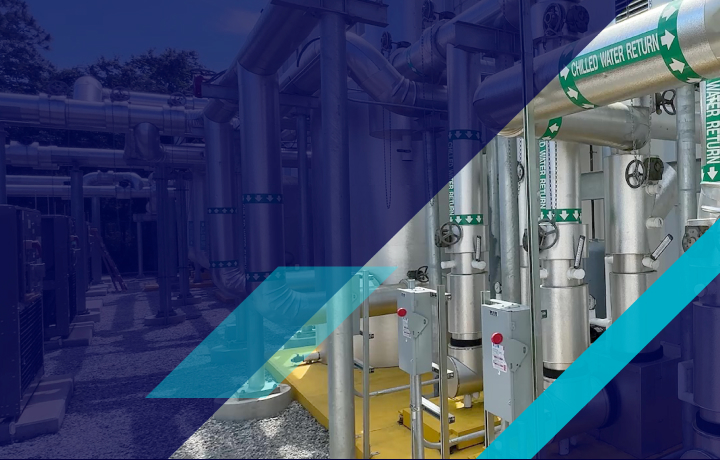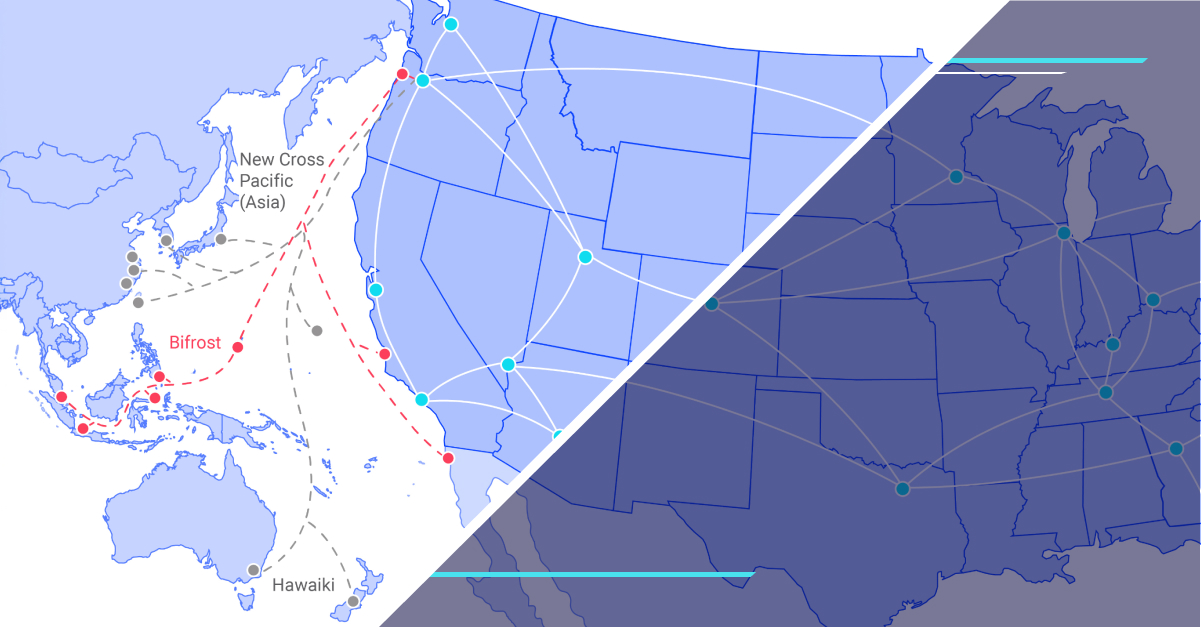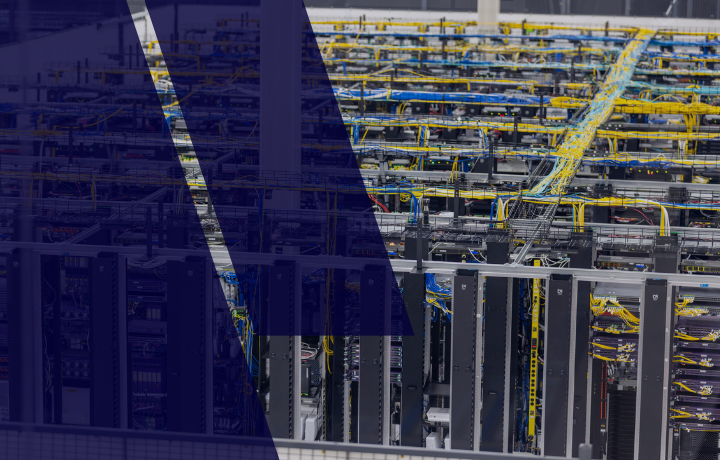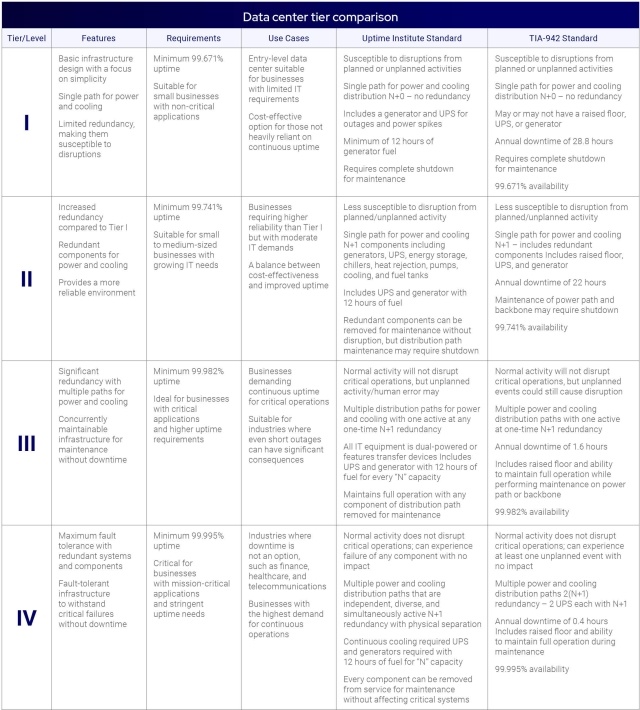Data center tiers: Classifications
If you're in the market for colocation, you've probably encountered data centers pushing their “tier” number. What do these numbers mean to you?

Colocation or other IT infrastructure service providers love to talk about their “tier” numbers. If you've been seeking these services, you've probably asked yourself: What does this number mean? The answer, too often, is a very vague “it depends.”
In previous articles, we have defined what is a data center. In this article, we'll answer what data center tiers are, their concept, and the most prominent tier systems. We'll also give you a downloadable chart you can use to help determine the right tier for your IT needs.
What are data center tiers?
When a data center facility is being designed or upgraded, tier numbers and similar designators are used to classify the facilities based on specific standards. The criteria vary by the organization setting the standards, but they typically quantify infrastructure, capacities, functionalities, and operational sustainability.
The concept behind data center tier classification
Data center classification revolves around establishing a standardized framework to evaluate and categorize data centers based on their infrastructure design, reliability, and operational sustainability. This classification system is crucial for businesses and organizations to make informed decisions about the data centers they choose to house their critical digital assets. The most prominent tiering systems you're most likely to encounter are from The Uptime Institute and the Telecommunications Industry Association.
The Uptime Institute
The most widely recognized and frequently referenced data center standard is the one created by The Uptime Institute. Developed in 1995, it provides a basis for comparing the uptime—also referred to as overall availability or system redundancy—between data centers.
Using a proprietary system, The Uptime Institute will certify—for a fee—that a data center's design meets its criteria for one of four tiers denoted by Roman numerals. (Other systems use Arabic numbers.) A Tier I data center offers a single, non-redundant distribution path serving IT equipment with no redundant capacity components. At the other end is a Tier IV data center, which is fully fault-tolerant and offers 2N redundant power and dedicated cooling equipment, among other features.
The Uptime Institute doesn't publish all the evaluation criteria for its tiers, and the various tier certification requirements are purposefully broad to allow for what the institute calls “innovation and client manufacturer and/or equipment preferences.” Compliance with a specific tier is assessed using outcome-based confirmation tests and operational impacts.
In 2013, the Uptime Institute also introduced operational sustainability standards for data center tier ratings and added gold, silver, and bronze ratings. Intertwined with the four-tier system, the new ratings are awarded based on the success of data centers' operational practices and not just design standards.
TIA-942
The Telecommunication Industry Association's TIA-942 Telecommunications Infrastructure Standard for Data Centers specifies data centers' cabling systems and network design standards. The TIA requirements are well-defined, covering physical construction, electrical power, cooling systems, monitoring security, redundancy, maintainability, and commissioning.
First published in 2005, TIA-942's tier classification system draws from the structured cabling work defined in TIA/EIA-568 and The Uptime Institute standard. Like The Uptime Institute system, TIA-942 classifies data centers into one of four tiers or levels. (The two have since agreed to differentiate their respective benchmarking systems, with the TIA discontinuing use of the word “tier.”)
TIA-942 has been updated to address the impact of the cloud on data center infrastructure. It now covers the newer switch fabric architectures that enable data centers to provide the low-latency, high-bandwidth, any-to-any device network that cloud computing requires.
What's the difference?
While it may look as if the two systems are nearly identical, they are very different. The Uptime Institute's system seeks to be goal-oriented rather than provide a rigid technical specification for how a data center should be designed and constructed. The TIA standard, in contrast, is particular in terms of its ratings and the associated requirements for each level of redundancy and availability.
Unlike The Uptime Institute, TIA has no formal procedure for evaluating a data center against its standard. Nor is there an official team of evaluators to enforce its standards. However, the specific requirements for each tier level are readily available, and there is no fee for their use in evaluating a data center.
Below, we define each tier level and how to choose the best one.
What are Tier I data centers?
Tier I represents the fundamental tier, offering basic infrastructure and minimal redundancy. It serves as an entry point for businesses with modest requirements, providing a foundational step into the world of data center reliability.
What are Tier II data centers?
As we ascend the tiers, Tier II introduces increased redundancy and redundant components, reducing downtime and enhancing reliability compared to its predecessor. Click here to learn the nuances of Tier II data centers, exploring how this tier has become a viable choice for businesses seeking a more robust infrastructure.
What are Tier III data centers?
Tier III marks a significant leap in reliability, featuring added redundant and backup components and redundancies that allow for maintenance without disrupting ongoing operations. Tier III plays a critical role in ensuring businesses experience continuous uptime, even in the face of planned maintenance activities.
What are Tier IV data centers?
At the pinnacle of reliability, Tier IV emerges with fault tolerance at its core. As we get to the top, the features of Tier IV data centers offer a sanctuary for businesses, providing minimal disruptions even in the face of critical system failures.
How to choose the best data center tier for you
Understanding their unique needs becomes paramount as businesses navigate the labyrinth of data center options and how to choose a data center provider. By delving into factors such as scalability, redundancy, and maintenance considerations, businesses can make informed choices that resonate with their operational goals.
Tier numbers and classification systems provide great starting points for evaluating a data center, but don't stop there. Conduct a thorough needs and risk assessment to determine what your data center's “must haves” are. How much downtime can you tolerate? Do you have compliance requirements?
Seek out data centers that have been audited to SSAE 16 standards in North America and the comparable ISAE 3402 standards for physical security and environmental controls in Europe and abroad. Those who have been audited to meet PCI DSS and HIPAA/HITECH are also more likely to help meet both data center compliance standards and security needs.
Ask about the data center's expansion plans. The most successful data centers fill up quickly; you don't want yours to run out of space and not be able to accommodate your company's growth or changing needs.
Remember, a higher tier number isn't necessarily better for your organization. A Tier III or IV data center would probably not be cost-effective if you are just running non-critical workloads. On the other hand, if you are running production workloads that require near 100% availability, a Tier I facility may not offer the security and reliability you need.
Data center tier comparison
Below, we present a chart comparing the different Data Center Tiers. Key columns include Features, Requirements, Use Cases, Uptime Institute Standard, and TIA-942 standards. We encourage you to download the data center tier comparison chart as a practical tool to visualize the distinctions between tiers and help you make a well-informed decision about your data center strategy.
Flexential: Your #1 data center choice
Tier numbers are only a starting point. Power specifications, carrier information, maintenance regime, business continuity and disaster recovery plans, and similar factors must all work together to meet your specific needs for the availability, reliability, and security of your IT assets.
At Flexential, we offer customized colocation, data center facilities, and interconnection options tailored to your specific needs, backed by a robust infrastructure and an unwavering commitment to reliability. Whether you need a single cabinet or numerous multi-megawatt deployments, our colocation and interconnection services are available nationwide on the FlexAnywhere® Platform.
Flexential features high-efficiency colocation for any deployment, with interconnection options to fit every requirement:
- Power scaling to 80+ kW per cabinet for high-density power demands
- Complete freedom and flexibility of deployment designs and technologies
- Retail and wholesale options, including remote hands
- Access to hundreds of carriers and international markets through subsea cables
- Private connections to leading cloud service providers —AWS, Microsoft Azure, Google Cloud and Oracle Cloud
- An industry-leading 100 Gbps network backbone
Learn more about Flexential colocation services and data centers, or schedule a consultation to get a custom evaluation of your unique IT requirements.





